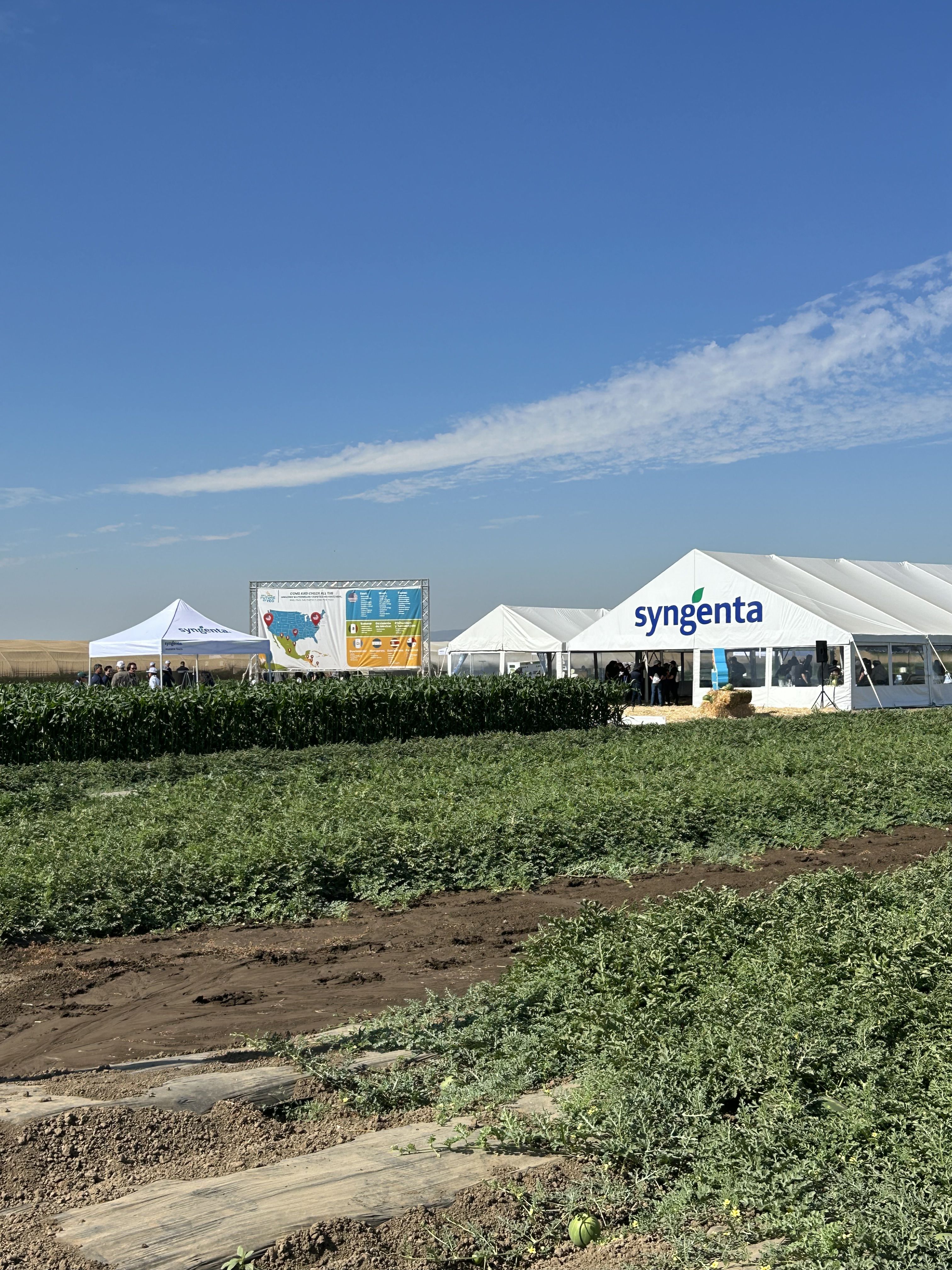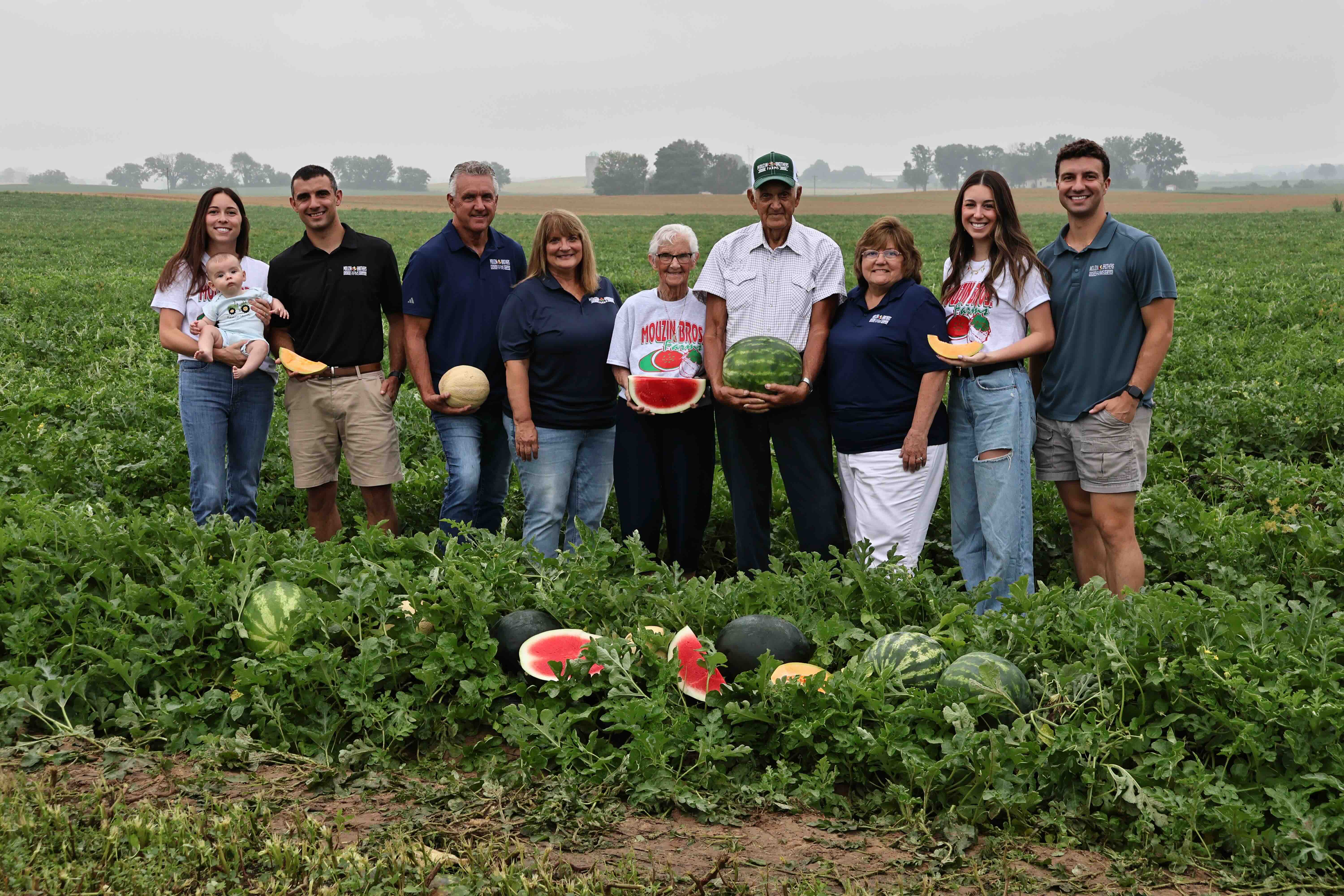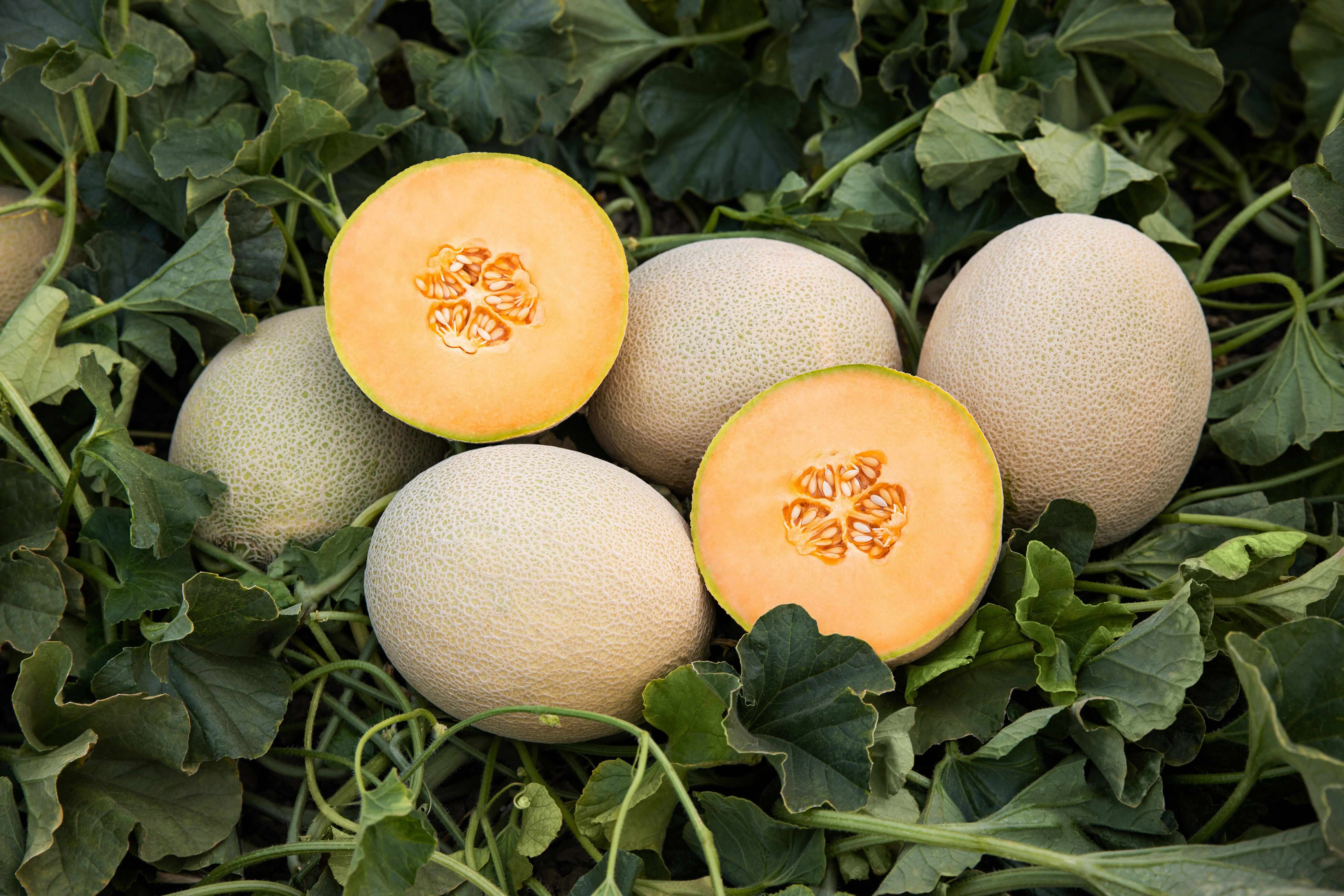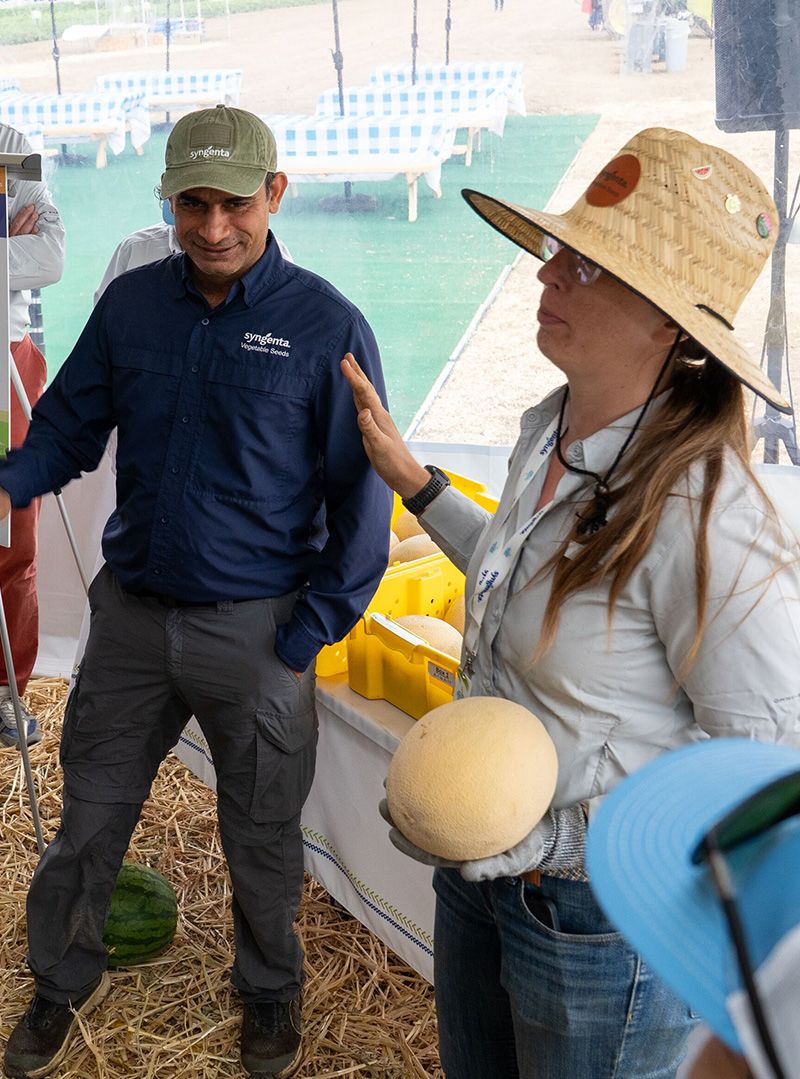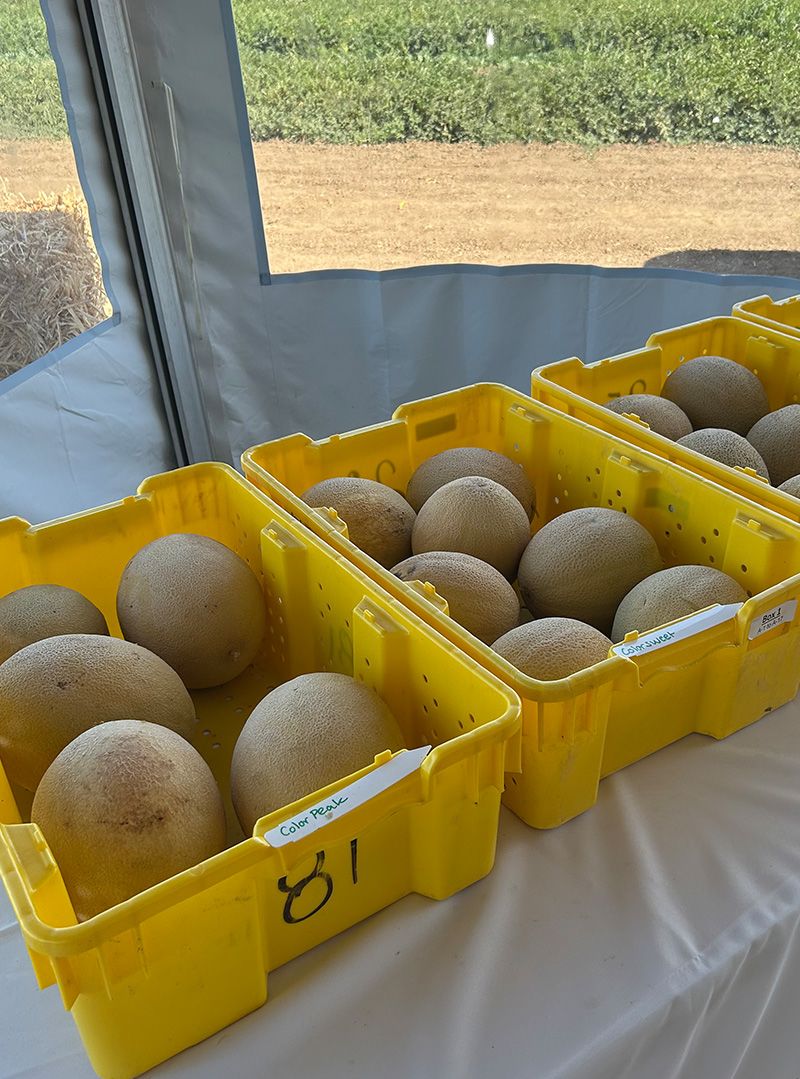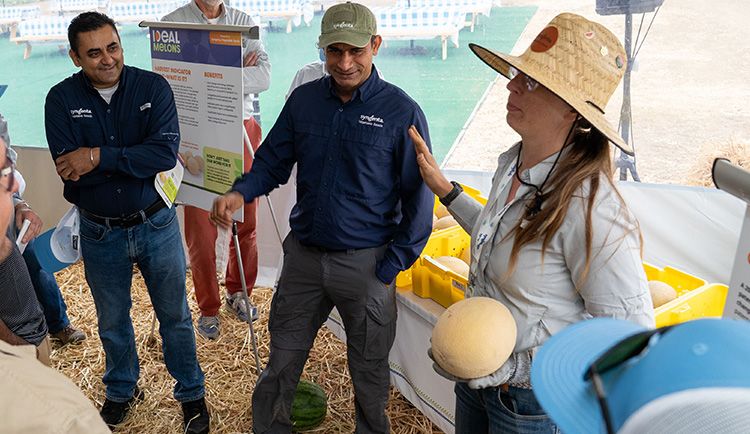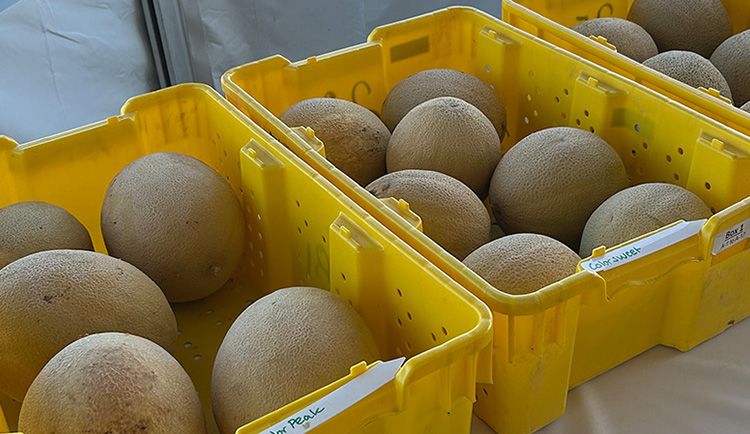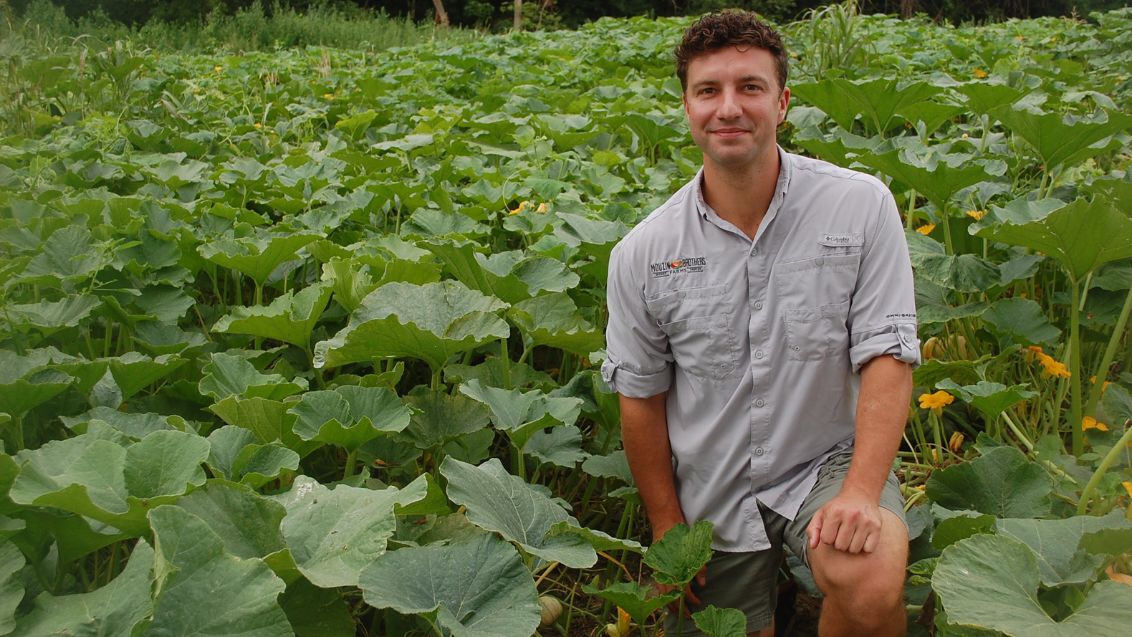Color-changing melon innovation ripe to revive US market
Smart breeding has solved ripeness guessing game
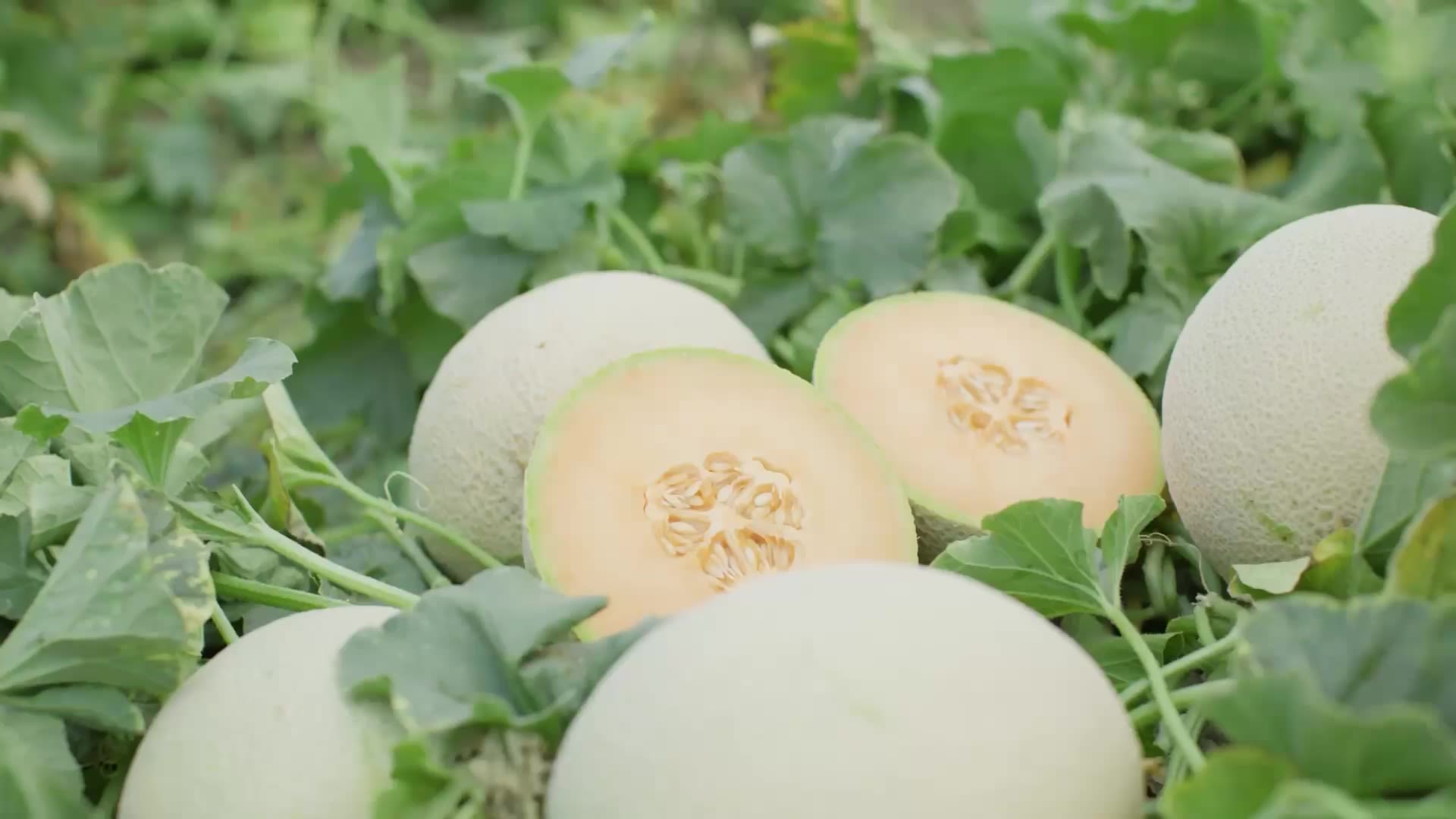
The August sun beat down on the fields in Woodland, California, as growers from across the United States, Latin America and other parts of the world walked between rows of cantaloupe plants during Syngenta's Future of Veg event. The temperature soared, but the growers' attention was drawn to something unique: long shelf-life melons that change color.
These ‘IDEAL Melons’ were changing from green to a golden straw hue as they ripened. For an industry that has spent a decade grappling with the unintended consequences of shifting to melons with longer shelf life, this visible transformation represents a potential turning point for American growers.
Syngenta's Future of Veg event was held in Woodland, California.
Syngenta's Future of Veg event was held in Woodland, California.
The August sun beat down on the fields in Woodland, California, as growers from across the United States,Latin America and other parts of the world walked between rows of cantaloupe plants during Syngenta's Future of Veg event. The temperature soared, but the growers' attention was drawn to something unique: long shelf-life melons that change color.
These ‘IDEAL Melons’ were changing from green to a golden straw hue as they ripened. For an industry that has spent a decade grappling with the unintended consequences of shifting to melons with longer shelf life, this visible transformation represents a potential turning point for American growers.
The trade-off
In the mid-2000s, the cantaloupe industry underwent a shift in the US. Traditional western shipper type cantaloupes were aromatic, flavorful, and changed color when ripe - but they had a critical weakness. After harvest, they had short shelf life of four to five days, making long-distance shipping nearly impossible. Growers also needed to harvest them 10-12 times over a period of a couple of weeks, which is a significant cost to their operation.
Enter the long shelf-life (LSL) melons. These LSL or harper type melons required only two to three harvests, significantly reducing cost of operation. Moreover, with their long post-harvest shelf life of two to three weeks, these varieties offered enormous economic advantages throughout the value chain. Harvest costs - which can represent significant cost of a grower's operational expenses - dropped dramatically. By 2014, the market had almost completely transitioned to LSL varieties.
However, LSL melons came with their own challenges. LSL melons achieved their longevity through reduced ethylene production, the same hormone that triggers color change and aroma development.
“The result was that melons remained stubbornly green on the outside, with virtually no visual cue to signal ripeness,” says Rakesh Kumar, who leads the Melons Breeding Program at Syngenta’s Woodland, California, research facility.
“Harvest crews had to examine subtle stem-end netting patterns to determine ripeness, a slow and error-prone process,” he says.
For consumers, the experience was one of confusion. Standing in grocery store aisles, shoppers picked up melons and sniffed them, as they'd done for decades. But LSL melons offered no olfactory clues.

Skyler Zapata
Skyler Zapata
"They're sniffing it and they're putting it back down thinking it is not ripe," says Skyler Zapata, a product specialist for Syngenta's melon program. "It could be ripe, but they have a difficult time telling. And if they ended up with an unripe one, they never purchased it again,” she says.
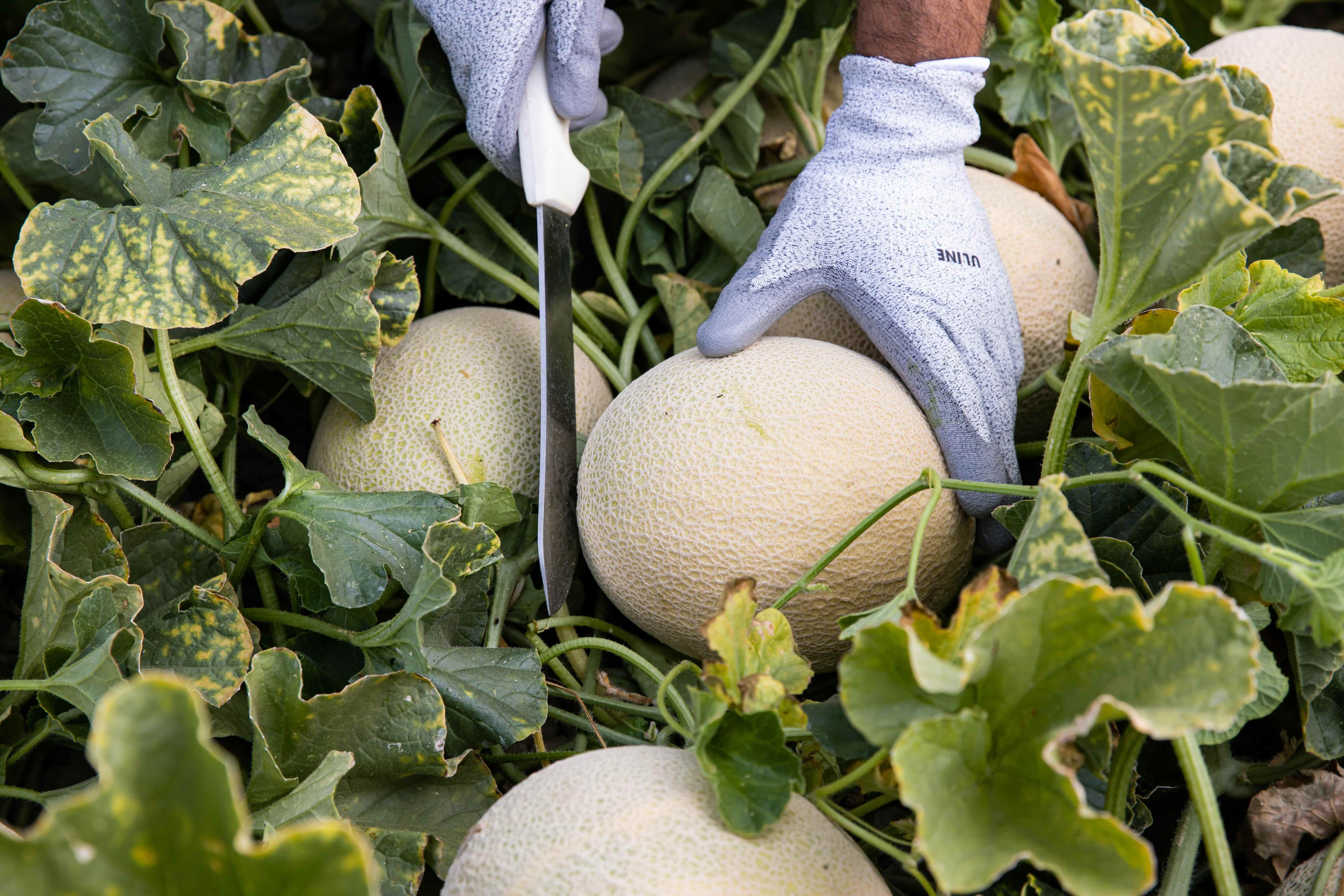
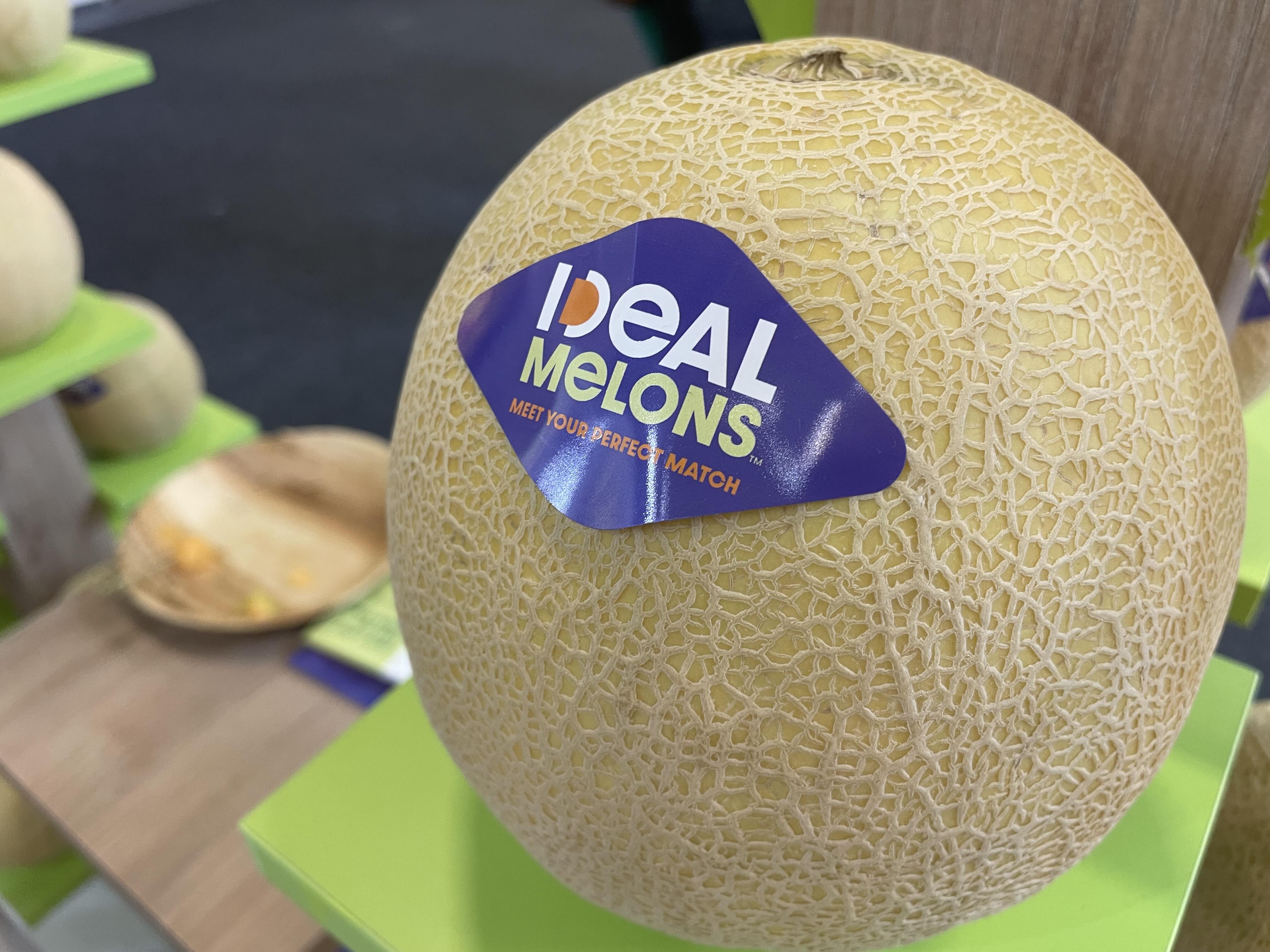
Watch the visible color change in IDEAL Melons over time.
Watch the visible color change in IDEAL Melons over time.
A market in decline
Brady Mouzin’s family has grown cantaloupes at their southern Indiana, US, farm for nearly 90 years. “My great-grandfather started this farm in 1935, using horse-drawn plows and a small plot of land. Over the years, he started growing more acres of cantaloupes and selling them to local markets,” Mouzin says.
The Mouzin family at their farm. Brady is standing at the far right.
The Mouzin family at their farm. Brady is standing at the far right.
Today, Mouzin Brothers Farms operates close to 2,000 acres of cantaloupes across their portfolio. They felt the impact of the shift to LSL melons.
According to United States Department of Agriculture (USDA) data, per capita consumption of fresh cantaloupe in the United States plummeted by half, from 11.1 pounds in 2000 to just over five pounds by 2022.
The problem was particularly acute during winter months, when the US imports all its cantaloupes from Central America. The economics of long-distance shipping often require harvesting entire fields at once to maximize efficiency. "When melons take two weeks to reach US retailers, ensuring optimal ripeness at every stage becomes challenging,” Zapata says.
Ensuring optimal ripeness at every stage from grower to customer was the challenge.
Ensuring optimal ripeness at every stage from grower to customer was the challenge.
Growers across the US were caught between the shipping demands of an expanding geographical market and the declining appeal of their product.
"We were in a predicament where we wanted to hold on to the Eastern type varieties because they had a beautiful color and they had a wonderful aroma," Mouzin recalls. "But we were being forced to look for something different because our shelf life was not meeting the standards that we needed to meet."
A decade of innovation
When Kumar joined Syngenta as a melon breeder around 2009, the industry transition to LSL melons was in full swing. By 2014, he had begun the systematic work of screening germplasm — searching through genetic material for traits that might allow melons to change color while maintaining agronomical advantages of LSL melons.
"The biggest challenge was finding the source for the trait," Kumar reflects. "Because if you don't have the right germplasm, you cannot make genetic gains."
His team identified a promising donor for the harvest indicator trait and spent years breeding this trait into commercial varieties using advanced breeding techniques.
"Introducing this trait into commercial germplasm was complicated because source was not a cultivated type," Kumar said, describing how early generations went through various shades of color change.
Studies conducted with University of California, Davis, validated that IDEAL Melons’ harvest indicator trait, developed by Kumar, changed color from green to golden or straw, providing a visual cue for ripeness across the supply chain.
Growers picked it around 40-60 percent color change, meaning partial color change with emerging shades of golden straw. Through the next eight days, whether at room temperature or cold storage, IDEAL Melons continued to get more golden straw, which grocery consumers intuitively associate with peak ripeness, while standard varieties stayed largely green.
An additional study by the same university also found that they delivered superior eating quality. Compared to standard LSL varieties, the IDEAL Melons showed significantly higher levels of volatile compounds indicating improved flavor and aroma, and more consistent sugar content and flesh firmness.
"This IDEAL Melons lineup basically takes the best of both worlds and combines it into a single cantaloupe," says Mouzin, who has been trialing the varieties. "You can have the color indicator, the nice aroma, and an extended shelf-life variety."
"It took us many years to get here," Kumar says. A timeline that underscores Syngenta's commitment to solving real problems for American growers.
Rakesh Kumar and Skyler Zapata at Future of Veg 2025 talking about IDEAL Melons.
Rakesh Kumar and Skyler Zapata at Future of Veg 2025 talking about IDEAL Melons.
IDEAL Melons' color post-harvest.
IDEAL Melons' color post-harvest.
A decade of innovation
When Kumar joined Syngenta as a melon breeder around 2009, the industry transition to LSL melons was in full swing. By 2014, he had begun the systematic work of screening germplasm - searching through genetic material for traits that might allow melons to change color while maintaining agronomical advantages of LSL melons.
"The biggest challenge was finding the source for the trait," Kumar reflects. "Because if you don't have the right germplasm, you cannot make genetic gains."
His team identified a promising donor for the harvest indicator trait and spent years breeding this trait into commercial varieties using advanced breeding techniques.
"Introducing this trait into commercial germplasm was complicated because source was not a cultivated type," Kumar said, describing how early generations went through various shades of color change.
Studies conducted with University of California, Davis, validated that IDEAL Melons’ harvest indicator trait, developed by Kumar, changed color from green to golden or straw, providing a visual cue for ripeness across the supply chain.
Growers picked it around 40-60 percent color change, meaning partial color change with emerging shades of golden straw. Through the next eight days, whether at room temperature or cold storage, IDEAL Melons continue to get more golden straw, which grocery consumers intuitively associate with peak ripeness, while standard varieties stayed largely green.
An additional study by the same university also found that they delivered superior eating quality. Compared to standard LSL varieties, the IDEAL Melons showed significantly higher levels of volatile compounds indicating improved flavor and aroma, and more consistent sugar content and flesh firmness.
"This IDEAL Melons lineup basically takes the best of both worlds and combines it into a single cantaloupe," says Mouzin, who has been trialing the varieties. "You can have the color indicator, the nice aroma, and an extended shelf-life variety."
"It took us many years to get here," Kumar says. A timeline that underscores Syngenta's commitment to solving real problems for American growers.
Rakesh Kumar (center) and Skyler Zapata (right) at Future of Veg 2025 talking about IDEAL Melons.
Rakesh Kumar (center) and Skyler Zapata (right) at Future of Veg 2025 talking about IDEAL Melons.
IDEAL Melons' color post-harvest.
IDEAL Melons' color post-harvest.
The challenge of change
Syngenta has successfully launched IDEAL Melons varieties in Central America, Australia and the US.
For Mouzin, who has been gradually expanding his IDEAL Melons acreage year over year, the trials have been successful despite the learning curve.
"Everyone understands what kind of problems this melon has already solved and what kind of potential it has for the entire cantaloupe category," he says, referencing discussions at the Eastern Cantaloupe Growers Association, where Mouzin Brothers Farms is a long-time member.
The operational benefits are real. While Eastern-type varieties require daily harvest - sometimes twice daily in hot weather - IDEAL Melons hold better in the field and ripen more evenly, allowing growers to pick larger volumes at once.
Syngenta's approach reflects long-standing collaboration with such grower organizations. “The development of IDEAL Melons came after collaboratively identifying an industry-wide challenge, investing in long-term research to address it, and supporting growers through the adoption process with technical education and field support,” Kumar says.
Early feedback from retail partners has been encouraging, suggesting that the color indicator is helping ensure melons reach stores at optimal ripeness rather than being picked too early or too late.
In the Western market, which is the biggest in the US for cantaloupes, growers are still getting used to the new variety. Zapata notes the educational component in helping growers adopt. “Our extensive post-harvest studies, technical documentation and ongoing support are helping growers get used to it,” she says. Events like the Future of Veg allowed growers from different countries to feel and taste IDEAL Melons.
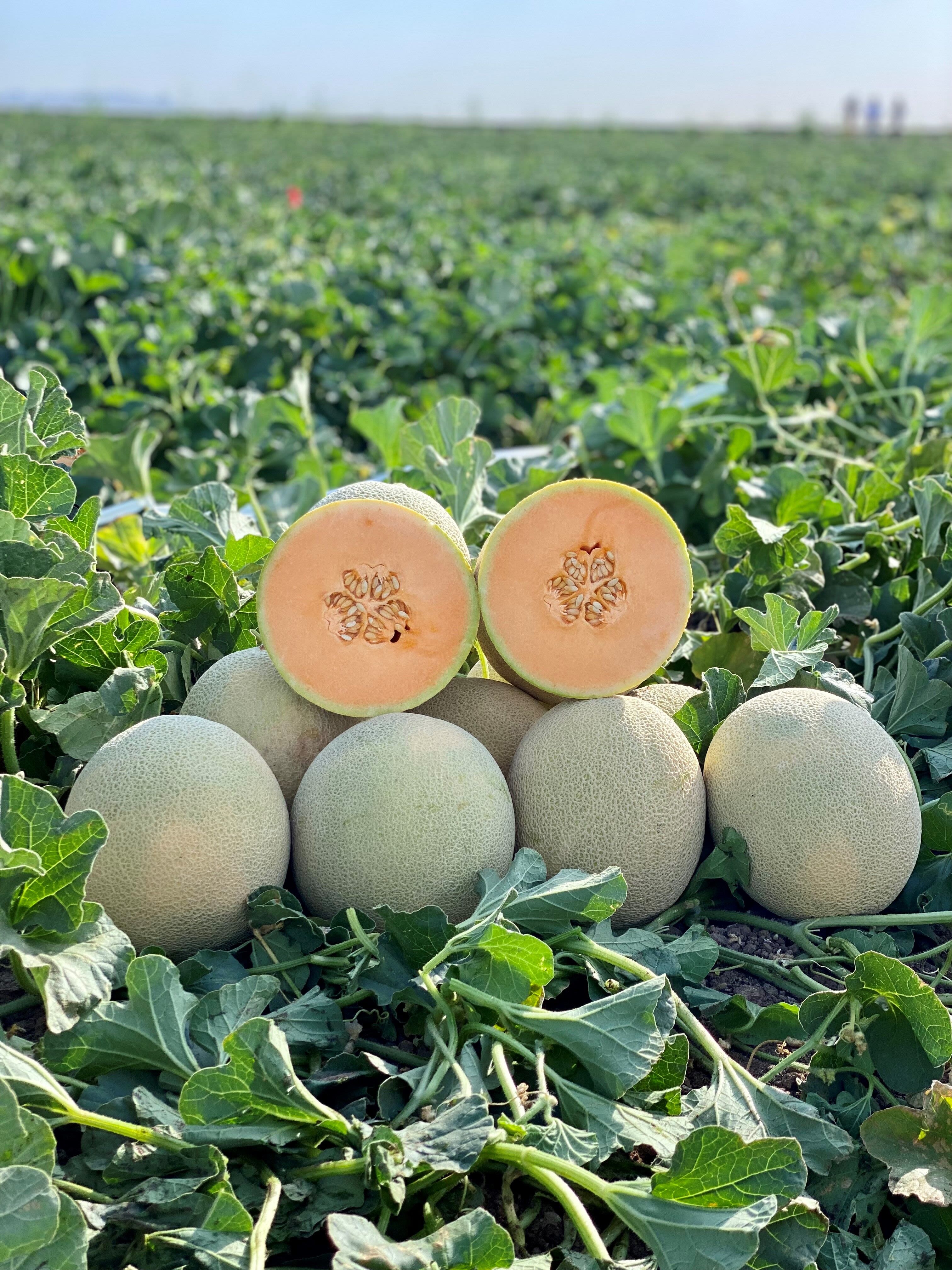
Looking ahead
The question is whether IDEAL Melons can help reverse the long decline in cantaloupe consumption. Kumar is optimistic about the consumer proposition. "The aromatics, while not quite at the levels of traditional cantaloupes, represent a significant improvement over standard LSL varieties. It's walking a fine line between shelf stability and sensory appeal,” he says.
Walking in the fields where four generations of his family have grown cantaloupes, Mouzin can now see at a glance which melons are ready for harvest - a simple sensory cue that represents a decade of cutting-edge research, hundreds of trials, and meticulous utilization of genetic diversity. In the rows of melons gradually changing color, there’s the promise of an industry revival.
Brady Mouzin can now see at a glance which melons are ready for harvest.
Brady Mouzin can now see at a glance which melons are ready for harvest.
"I think this could be that answer to bringing customers back to cantaloupe,” Mouzin says. "It gives the final customer that same satisfaction that it's giving the grower."

This year, Syngenta is celebrating its 25th anniversary. We are proud of our continuous innovation and contribution to the food system over the past quarter century. Check out more of our stories about innovation.
This year, Syngenta is celebrating its 25th anniversary. We are proud of our continuous innovation and contribution to the food system over the past quarter century. Check out more of our stories about innovation.

